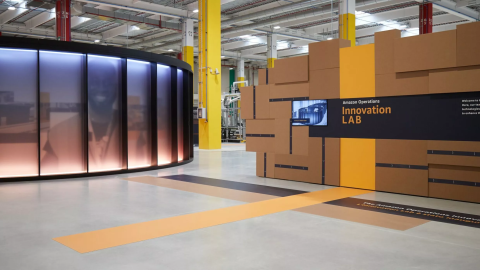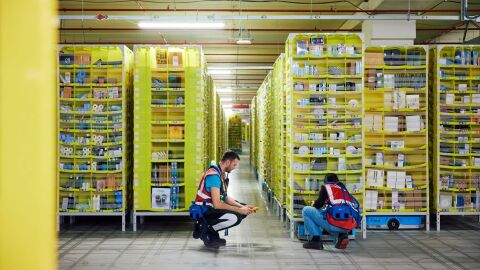Image above: Vodafone CEO Margherita Della Valle and Amazon Senior Vice President of Devices and Services Dave Limp meet at Amazon offices in Seattle. The customer terminal antenna they appear with will allow Project Kuiper customers to send and receive data to and from Project Kuiper satellites.
People without reliable internet connectivity cannot easily access simple tools like email, web browsing, and online shopping. They also miss out on deeper opportunities like virtual healthcare, education, and financial services.
Amazon created Project Kuiper, its satellite broadband programme, to help close that digital divide by delivering affordable, high-speed internet service to unserved and underserved communities around the world. Project Kuiper’s satellite network will serve tens of millions of customers, but it is only one piece of the puzzle.
That’s why we’re also teaming with local and regional partners in the telecommunications industry—often called telcos—to combine Project Kuiper’s satellite connectivity with existing telco networks and infrastructure in countries around the world, helping reliably connect even more people in more places no matter how remote.
“Hundreds of millions of people around the world live in places without reliable broadband, and bringing these communities online will require a wide range of technologies, including fiber, wireless, and satellite,” said Naveen Kachroo, Project Kuiper’s director of business development and product management.
“Project Kuiper’s satellite technology complements telecommunications companies’ ongoing efforts to connect the unconnected, and we plan to continue working with local and regional telecommunications operators to help them extend the reach of their networks. At the same time, our satellite network is highly flexible, and we also want to work with telco partners to better serve customers with demanding workloads even in regions well covered by traditional options.”
Remotely connecting cellular towers

The combination of satellite broadband and telcos’ traditional mobile, fixed wireless, and fiber optic networks can bring internet access to more regions sooner—even locations that have traditionally been cut off from service due to geography and terrain. It can also deliver more reliable and consistent coverage in areas where connectivity is sufficient in some areas, but absent in others due to the landscape.
Project Kuiper is already partnering with Vodafone in Europe and Vodacom in Africa to help those companies extend coverage areas for their 4G/5G cellular networks. The companies will install Project Kuiper customer terminals alongside cellular towers, using Project’s Kuiper’s satellite links to provide the connections from the towers back to the companies’ core networks. In this way, the companies can extend their cellular coverage without the time and expense required to build out and maintain fiber or fixed wireless infrastructure linking back to more densely covered regions. The result is better, more consistent cellular coverage in rural and remote areas around the world.

Reliable backup and rapid support for large and unexpected events
For large enterprises that require reliable connectivity, the combination of traditional telco service with backup satellite broadband service from Project Kuiper means they can continue operations even if they temporarily lose their primary means of connectivity. Similarly, following natural disasters and other emergencies that damage communications infrastructure, telcos can deploy Project Kuiper customer terminals to quickly provide data connectivity for first responders and impacted communities. Paired with telcos’ own emergency response capabilities, such as mobile communications hubs, Project Kuiper service can make it easier for first responders to coordinate activities during crises.
Project Kuiper’s satellite broadband network gives telcos flexibility to rapidly and temporarily provide coverage at scale in regions that are beyond their typical service areas. For example, during festivals in remote locations, telcos could use Project Kuiper satellite connectivity to extend and augment their wireless coverage. Likewise, media and entertainment customers can use Project Kuiper connectivity to move large volumes of media content from remote sites to their production offices for processing, speeding up the timeline for getting content to their audiences.












